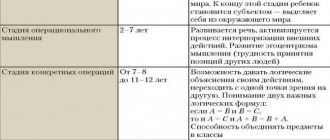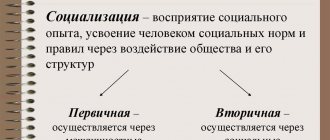Human Temperament - Definition
Temperament
- this is a stable set of individual psychophysical properties of a person associated not with the content, but with the dynamic aspects of activity.
Simply put, temperament refers to a person’s ability to react to external stimuli and move from one reaction to another. Temperament is determined by the type of higher nervous activity, which consists of three components - the “strength” of the nervous system, its “mobility” and “balance”.
Today, the theory of temperaments is only one of many systems that describe the types of human personality. And once upon a time it was the only such system. The doctrine of them was developed by the ancient doctors Hippocrates and Galen, who were confident that a person’s character type depends on the predominance of one or another “vital juice” in his body - blood, lymph, yellow and black bile. And the word “temperament” itself, translated from Latin, means “mixture” - it meant a mixture of these “vital juices”.
What is an individual style of activity?
One of the important scientific problems in the study of temperament is the problem of taking into account and mastering the psychodynamic characteristics of human behavior in various types of activities. The existence in the human psyche of stable dynamic energy characteristics, formed on the basis of biological factors, allows a person to use his energy capabilities in the most optimal way. Knowing his energy characteristics, a person can consciously regulate the regime, rhythm, and intensity of various types of activity. In psychological studies Merlina V.S., Klimova E.A. the problem of taking into account and mastering an individual’s psychodynamic characteristics is associated with the development of an individual style of activity. Individual characteristics of a person determine an individual style of activity (E.A. Klimov), which is:
- a sustainable system of techniques and methods of activity;
- this system is conditioned by certain individual personal qualities;
- this system is a means of effectively adapting to objective requirements;
- These are those features of the style of activity that are determined by the typological properties of the human nervous system.
An individual style of activity is a stable, individually specific system of psychological means, techniques, skills, methods, and ways of performing a particular activity. The possibility of different individual styles of activity lies in the existence of a “zone of operational uncertainty”, allowing the choice of different ways of carrying out activities. The intensity of motivation for any activity determines the presence and degree of expression of an individual style of activity. It allows people with different individual typological characteristics of the nervous system, different structures of abilities, temperament, and character to achieve equal effectiveness when performing the same activity in different ways, while compensating for individual characteristics that impede the achievement of success. At the same time, the individual style of activity may not be optimal from the point of view of activity efficiency.
Types of temperaments and their characteristics
Ancient scientists thus identified the main types of temperaments, of which there are four:
- A sanguine person
is an energetic, cheerful and sociable, balanced individual. - A choleric person
is an energetic but unbalanced person, subject to fits of rage and anger, who has difficulty controlling his actions. - A phlegmatic person
is a balanced, calm and slow person who scrupulously carries out his duties and is not prone to fuss. - A melancholic person
is an unbalanced and weak person, subject to feelings of fear and sadness.
In principle, this classification of temperament types has not lost its meaning today, however, pure melancholics, cholerics, sanguines and phlegmatics are quite rare. Therefore, it usually makes sense to talk only about a mixed type of temperament.
The classical system is widely in demand in culture - literature, science, art. Of course, modern scientists understand that there is no “predominance of vital juices”, and the type of temperament is determined by an imbalance in the neurochemical system of the body. If the imbalance reaches an extreme degree, then the temperaments flow into the so-called psychiatric profiles, and each of them can develop into a specific mental disorder: choleric people suffer from impulsive personality disorder, sanguine people suffer from hypomania, phlegmatic people suffer from schizoid personality disorder, and melancholic people suffer from anxiety disorder.
The study of temperaments was carried out throughout the twentieth century and continues to this day. Many researchers note that the classical understanding of the type of temperament consists of two components: behavioral activity and emotionality. Based on this, improved classifications were built. And the fact that a person’s temperament depends on the type of higher nervous activity was first proven by the great Russian scientist I. P. Pavlov. He established that higher nervous activity has a similar structure in humans and higher animals. Thus, a certain type of temperament is characteristic not only of humans, but also of the most developed mammals.
There are other theories and classifications that divide personalities according to their properties. One of the most popular classifications is the division of people into extroverts and introverts proposed by Carl Jung. The first unite choleric and sanguine people, and the second - phlegmatic and melancholic. Extroverts are focused on interacting with external stimuli, while introverts are focused on their inner life.
What are the ways to form an individual style of activity?
There are four ways to adapt temperament to the demands of activity.
The first way is professional selection , one of the tasks of which is to prevent persons who do not have the necessary temperamental properties from participating in this activity. This path is implemented only when selecting for professions that place increased demands on personality traits (power system dispatchers, mine rescuers, divers, pilots, etc.). Activities in these professions are associated with regular emergency stress, risk, danger, and great responsibility. Professional selection helps to select candidates with the most suitable psychophysiological properties for a given specialty, since some of the qualities required by some professions are difficult to train and are limited by temperamental properties. For example, it is known that a poorly developed sense of time or a low speed of motor reaction can only be developed within certain limits through individual training. In order to increase the efficiency of professional selection, special tests have been developed to assess the characteristics of attention, the accuracy of time estimation, and the speed of motor reaction. Not only professional selection is important, but also career guidance, i.e. determining for each person a work activity that would correspond not only to his interests, but also to his individual characteristics and capabilities. Research shows that individuals who have received professional specialization taking into account their psychophysiological characteristics experience great satisfaction from their work, which has the most favorable effect on their productivity.
The second way - adapting temperament to activity - is to individualize the requirements, conditions and methods of work placed on a person (individual approach). At the same time, training and education should not try to change temperament, but help the student overcome the shortcomings of a particular temperament and develop its positive aspects. First of all, this is an organization of work and rest that takes into account the uniqueness of the child’s temperament. Control over the pace of work, taking into account the characteristics of the students’ temperament, should be to ensure that the active ones do not allow superficial and careless completion of tasks, and the slow ones complete them faster. The innate properties of temperament are manifested in a person in such mental processes that depend on upbringing, on the social environment and on the ability to control one’s reactions. Therefore, a specific reaction to a situation can be determined both by the influence of characteristic differences in the nervous system and as a result of training and professional experience. For example, a high reaction speed in an experienced driver, pilot, boxing or fencing master is not necessarily a natural property of their nervous system; it can also be achieved as a result of training and education. But the limits of speed development are determined by the innate properties of the nervous system.
The third way is to overcome the negative influence of temperament through the formation of a positive attitude towards activity and corresponding motives. For example, in a very interesting lesson that causes increased activity among students, the degree of restraint of choleric people is no less than that of sanguine people, and the performance of melancholic people is no lower than that of phlegmatic people.
The fourth, main and most universal way of adapting temperament to the requirements of activity is the formation of its individual style. An individual style of activity is understood as an individual system of techniques and methods of action that is characteristic of a given person and is appropriate for achieving a successful result. A person usually chooses such techniques and methods of performing actions that best suit his temperament, but he does not always choose them consciously. The teacher’s task is to assess their appropriateness and help the student consciously and creatively develop an individual style of activity.
Properties of temperament
As you can guess from the above, temperament is a “composite” characteristic. The introduction of this concept into science was an attempt to describe the entire personality of a person - in the understanding that was developed in the ancient era. Over many centuries, it has been established that the human personality has many more properties and “facets”, so the theory of temperaments may not be completely outdated, but it needs serious improvement.
The increased interest in temperament in the modern world is associated, in particular, with the development of the very concept of “personality”. This has a certain connection with changes in socio-political life, the struggle for civil rights, social policy and other phenomena and processes, the center of which is the person as an individual.
The recognition of “personality” in a person happened not so long ago, and in the old days no one thought about it. Thus, in ancient times and in the Middle Ages, the description of a person was limited to the estate, caste or class system, age and gender, and no special attention was paid to individual character traits. This was especially characteristic of Russian culture, in which interest in the human personality arises much later than in European countries. The works of Russian authors of the early 18th century are replete with foreign words (“bisaria”, “humor”, etc.), denoting concepts that seem elementary today: “character”, “inclination”, “impression” and others. And even many Russian and Soviet writers of the first half of the twentieth century refused to recognize the word “mood,” calling it “an unsuccessful invention of decadents.” The opponent of this word was, in particular, Korney Chukovsky. However, time passed, and the need to understand the subtle features of an individual’s behavior and emotional life was felt by everyone - ordinary people interested in building relationships with others, politicians, criminologists, and doctors.
In this regard, it is important to understand the properties of temperament. And they determine a lot: at what speed a person can think, act, do work, how well he remembers information, how happy, sad, angry he is, how quickly he can change his mood. Temperament can significantly influence a person’s career and self-realization. At the same time, however, a person with a certain temperament is not necessarily smarter or stupider in relation to a person with a different temperament, and, for example, a more well-read, quick-witted and inventive phlegmatic person may be less successful in scientific research than his slightly less developed one, but a more active and sociable sanguine colleague.
Temperament even affects a person's handwriting. A more active individual’s handwriting is taller, wider and more sweeping, the distance between the letters is quite large, while a less active individual’s handwriting is lower, narrow and “compressed”, the letters are as close to each other as possible. At the same time, a person with a higher activity has a more difficult time mastering small details of letters and signs, while a person with a lower activity can master small details, but not large ones.
The nature of human activity is also manifested in communication. The more active person’s speech is loud, bright and rich, faster, with well-defined gestures, facial expressions, and intonations. An inactive person shows much less expressiveness in speech; such speech can be abrupt, monotonous, and the face creates the impression of a “stony” face.
At the same time, positive words and images predominate among sanguine and phlegmatic people, while choleric and melancholic people often have more negative ones. Sanguine and choleric people are the first to make contact, they show a keen interest in communication, they want to share their thoughts and feelings with others. On the contrary, phlegmatic and melancholic people prefer solitude and are not often the first to start a conversation, but they are the first to willingly end the conversation. “Slow-tempered” (melancholic, phlegmatic) have difficulty switching from one topic to another and from one person to another, while “excitable” (choleric and sanguine) are ready to talk about everything and with everyone at once. Phlegmatic people and melancholic people may therefore seem annoying; they can harp on the same topic for hours.
People of different types have different attitudes towards interpersonal connections and friendship. Sanguine people love to make as many friends and acquaintances as possible and know how to attract them to themselves; Choleric people also tend to have a large number of acquaintances, but their behavior can repel others. Phlegmatic people form close relationships with a small number of people, but these relationships are usually strong and long-lasting; melancholic people can also be attached to a small number of friends and acquaintances, but often the connections quickly collapse.
Characteristics of temperament should be taken into account when choosing a profession and type of activity, even a specific organization. For example, professional sports are “tailored” for sanguine people and especially choleric people, and people with a slow pace of activity are not suitable for this area, unless it is chess. But even in “mind sports”, the ability to think quickly and react quickly, quickly assess your position, make moves and not lose your temper in case of a mistake is often required; In professional competitions, as is known, the running time is limited. An important problem in chess and other intellectual games is time pressure - lack of time to think about moves. Apparently, taking into account the interest in such games mainly among phlegmatic people, the eleventh world chess champion Robert Fischer proposed the idea of “soft” time pressure, in which a little more time is added to the player after each move; Even a special watch design is used for this purpose. Currently, “soft” time pressure is widely used in chess and other board games.
However, research has established that temperamental characteristics have virtually no effect on the performance of a person in an environment that can be described as normal. Both excitable and inhibited workers show the same results and do the same work if, simply put, they are not distracted by anything - extraneous noise, lack of time, too many or few employees in the room, poor temperature conditions, and so on. But the fact is that it is very difficult to create absolutely normal conditions for work, and then the peculiarities of temperament come into force.
How do people with different personality characteristics work?
Choleric people have a very high performance capacity, but they tend to get carried away too much, which is why they waste their energy. Sanguine people also have a tremendous capacity for work, but they realize it only if they like the work; if they don’t like it, they begin to be indifferent to their work and get bored. Phlegmatic people work slowly, but are distinguished by equanimity, calmness and perseverance, thanks to which they perform their work conscientiously. Melancholic people tend to react sharply to external stimuli; they are absorbed in their internal experiences; They can conscientiously fulfill their duties only in the most calm and positive environment in the presence of any positive impressions.
The famous Soviet psychologist B. M. Teplov established that workers with different temperaments differ not in the final results of their activities, but in the ways of achieving these results. That is, the individual style of activity of a particular employee primarily depends on a specific temperament. Knowing this allows you to organize the work of the organization in such a way as to get maximum performance from each employee.
For example, for melancholic people you can set a flexible schedule, you can put them in a room with a minimum amount of irritating factors; Phlegmatic people should not be required to complete work within a strictly established time frame, especially a short one; instead, it is better to focus on the quality of the product. Sanguine people need to be interested in work by creating conditions in which they can demonstrate their abilities and demonstrate their skills to others.
Temperament is a set of innate human properties. And when they say that these innate, initially inherent properties influence the behavior, work of a person and his activity in general, then this can cause bewilderment among the unprepared: after all, it is known that a person is a teachable being, and he learns everything throughout his life. Indeed, a person learns many things, but the limits of learning are still influenced by the innate properties of the individual.
The standard of the educational process is the school, and it is enough to look at any school class to identify conscientious and immersed in study phlegmatic people (often they are “nerds”), and choleric people who skip classes for the sake of sports achievements, and those who attract everyone’s attention, artistic sanguine people, and melancholic people. who are often “difficult teenagers” and also experience learning difficulties due to their nature. Of course, one cannot say that a phlegmatic person will necessarily be an excellent student, and the destiny of a melancholic person is correctional education, but for success in educational activities, each student needs an individual approach, and not every school can provide this.
Among the outstanding people were representatives of all temperaments and their combinations. Thus, Pyotr Ilyich Tchaikovsky was described as a typical melancholic person. Yesenin, Chekhov, Gogol, Chopin were the same. Beethoven, Pushkin, and Byron were choleric. Typical phlegmatic people are Ivan Krylov, Kutuzov, Galileo, Kant. Sanguine people - Mozart, Prokofiev, Balzac, V.I. Lenin.
Representatives of all types can be found among modern politicians. Gennady Zyuganov is a phlegmatic person, Grigory Yavlinsky is a melancholic person, Bill Clinton is a sanguine person, and Vladimir Zhirinovsky is a pronounced choleric person. As we see, in any profession there are “excitable” and “inhibited” representatives, although some types of activities are more suitable for one or another personality type: for example, among politicians, a larger percentage of truly outstanding personalities are observed among choleric and sanguine people - these are severe dictators, great reformers, revolutionaries, prominent political figures, brawlers. Among phlegmatic people, the majority are mathematicians, physicists, chemists, and philosophers; even the composer Alexander Borodin, a famous phlegmatic, was no less an outstanding chemist. Among the melancholic people, the most outstanding were, of course, poets, writers, composers, and artists.
The friendship of two great composers – Chopin and Liszt – became widely known. The first was a melancholic personality, and the second was a typical choleric person. This, however, did not interfere with their friendship, and even vice versa - the qualities of one complemented what was missing in the other. The nature of the music and the style of performance itself was significantly different for both composers. Chopin could not play in large halls; he preferred small aristocratic rooms. Liszt, on the contrary, loved performing in huge halls, and the more people there were at the concert, the more inspired he was. Contemporaries wrote that at the end of the concert, Liszt stood in the middle of the hall as a winner among defeated enemies. They say that at one of the dinner parties Liszt played one of Chopin’s works, and in his own manner. Chopin, who was present there, did not like this performance; however, when his friend played another of his etudes, even Chopin himself was delighted.
How does temperament manifest itself in an individual’s style of activity?
Since each activity makes certain demands on the human psyche and its dynamic characteristics, there are no temperaments ideally suited for all types of activity. Take, for example, the activities of energy system operators, chemical plants and the activities of a worker on an assembly line. If in the first one people with high anxiety and low noise immunity cannot work, then in the second there are no special high requirements for these psychological characteristics of a person. It is only desirable that he endure monotonous work relatively painlessly. The role of temperament in work and study is that the influence on the activity of various mental states caused by an unpleasant environment, emotional factors, and pedagogical influences depends on it. The influence of various factors that determine the level of neuropsychic stress (for example, performance assessment, acceleration of the pace of work, disciplinary action, etc.) depends on temperament. Activity is carried out not by temperament, but by personality. Features of temperament appear, first of all, in the originality of methods, and not in the effectiveness of activity. Persons with temperaments that are opposite in terms of mobility resort to different tactics of action in the same work situation. Thus, those who are mobile perform urgent operations faster (for example, according to E.A. Klimov, eliminating a broken thread by a weaver), but only when the need for this arises; while inert ones are distinguished by more careful attention to preparatory work, preventing the need for urgent action. Outstanding production successes are achieved by those workers whose methods and style of work correspond to their individual characteristics. Thus, temperament determines the individual style of activity.
Differences between temperament and character
Temperament is the foundation for a larger characteristic of the human personality - character. Sometimes these concepts are not distinguished and confused, although, in a strict sense, they are not the same thing. It was said above about acquired skills, habits, character traits and their difference from innate ones. So, character is precisely the acquired mental properties, although formed under the influence of innate qualities.
The character of representatives of different temperaments may be the same, but it manifests itself in different ways. Thus, phlegmatic people and sanguine people can be equally sociable, but the external manifestation of this sociability will be significantly different. Some specific innate qualities can predetermine the development of some character traits and counteract the emergence of others. It also happens that the development of certain character traits allows a person to restrain negative and currently undesirable innate properties; this phenomenon lies, in particular, at the basis of willpower.
Knowledge about the dependence of innate and acquired qualities allows you to find an individual approach to raising children. A child with any personality type (melancholic, choleric, sanguine or phlegmatic) can develop any character traits, but the methods of education must be different.
Let's return to outstanding personalities. Mikhail Illarionovich Kutuzov was a phlegmatic person by nature, but the corresponding innate mental properties alone could not have made him a famous commander - a choleric person would have been more useful here. Education, training and self-improvement made Kutuzov the way he went down in history.
Isaac Newton seems to us a pronounced phlegmatic person, but his contemporaries described him as a typical melancholic person. Russian Emperor Nicholas I was also melancholic, famous for his harsh “stick” regime of government, military discipline and ruthless fight against corruption - that is, all that, in theory, should reveal a choleric person in him.
In general, character is something that needs training, development and hardening. As a result, even a person with weak innate abilities can show strength of character. This is often observed in emergency situations - for example, during war.











